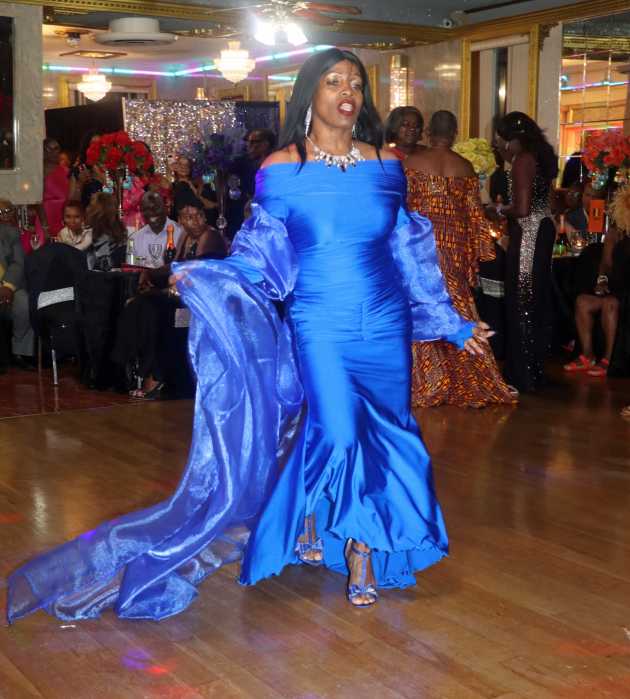Until someone discovers a fourth dimension, a different sentient
life form, or a different emotion for the human life form we
know, it’s highly unlikely that any artist will come up with
a totally new creation. In the meantime Brooklyn audiences can
get a taste of what total originality might be like by seeing
"How Wang-Fo Was Saved," presented by Hanne Tierney’s
Theater Without Actors at five myles, a performance and exhibition
space in Crown Heights.
In the 11th Century a Sung Dynasty painter wrote, "There
is little originality in content, but much in how it is expressed."
Tierney writes that this short sentence contains the essence
of Chinese paintings. It also may contain the essence of Tierney’s
own work.
Tierney’s search for a theater without actors is clearly in the
tradition of the Symbolist and early Modernist stage, as expounded
by the Belgium playwright and poet Maurice Maeterlinck who wrote
in 1888 in Le Jeune Belgique: "The staging of a masterpiece
with the help of human elements is a contradiction. Every masterpiece
is a symbol, and the symbol will not tolerate the active presence
of man."
Tierney’s unique and visionary work has been recognized and supported
by NEA grants, the Fund for US Artists and the Jim Henson Foundation.
And in 2000, five myles was awarded an Obie grant for being a
space "where magnificent contemporary works fully engage
the folks in the neighborhood."
But unlike too many avant-garde and radical artists, Tierney
produces works that stretch the audience’s imagination without
moving into that dangerous territory beyond the viewer’s comprehension
or caring. "How Wang-Fo Was Saved" is a deeply emotional,
intensely spiritual, and visually and aurally beautiful production.
Previously Tierney’s abstract performers were two-dimensional
geometric shapes as in "Flatlands" with Jene Highstein
for BAM’s Artists-in-Action series, or sensuous fabrics and stainless
steel coils as in Oscar Wilde’s "Salome," presented
by the Henson Festival at Danspace last year. In "How Wang-Fo
was Saved," Tierney’s performers are bamboo fronds, silks,
stiffened robes and glowing lanterns.
Tierney stands or crouches off to one side of the stage, in full
view of the audience, and manipulates her performers through
a counterweight system of 114 strings. The quantity of strings
and the quality of Tierney’s manipulation produce gestures so
subtle and nuanced that bodiless robes and glowing lanterns are
invested with human emotions in their purest and most intense
form. Movement becomes immensely moving.
Tierney’s adaptation of this ancient Chinese legend is based
on a short story by Marguerite Yourcenar. Actor Andrew Pang sonorously
narrates it, while Tierney and Richard Clarke speak the characters’
dialogue.
The play opens with the old painter Wang-Fo and his disciple
Ling traveling along a road, trying to stay alive by selling
paintings for food. After Ling is killed and Wang-Fo dragged
off to face the emperor and pay for an as yet undisclosed crime,
the narrative flashes back to explain how Ling left home and
family to follow this painter who "loved the image of things
and not the things themselves."
This journey into the past introduces the audience to Ling’s
long-suffering parents, his timid wife and the emperor’s submissive
concubines. When the narrative returns to the present, it becomes
obvious and inevitable that the only way Wang-Fo can save himself
is through his art.
Composer-musician Jane Wang accompanies the action with Asian
music she produces with the double bass, colorful plastic tubes,
small cooking utensils from Chinatown and her voice. The play
also benefits from the talent of German video artist Stefanie
Fischer and light designer Trevor Brown, who turn night to day
and surround the audience in ethereal light or engulf it in the
rising flood that eventually saves Wang-Fo.
During his life’s journey, Wang-Fo frequently quotes from early
T’ang Dynasty writings on painting – reflections and instructions
on art that stress the importance of balancing rigorous work,
cosmic intuition and spiritual harmony. This balance is important
because, as Ling’s mother says, "Seeing and knowing do not
travel on the same road."
By isolating movement and gesture, Tierney emphasizes the symbolic,
abstract and universal nature of theater. Movement, gesture and
music become wordless narrative touching us on a level far deeper
than thought or reason.
As Wang-Fo learns and the play about him illustrates, it is art
that forms the bridge between the two separate paths seeing and
knowing travel.
"How Wang-Fo Was Saved" plays
through Nov. 10, Thursday and Friday at 7 pm, Saturday at 7 and
9 pm. Tickets are $20, students and seniors $10. Five myles is
located at 558 St. John’s Place. For reservations, call (212)
353-1238 and for more information, call (718) 783-4438.

























